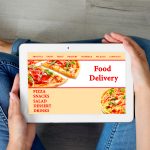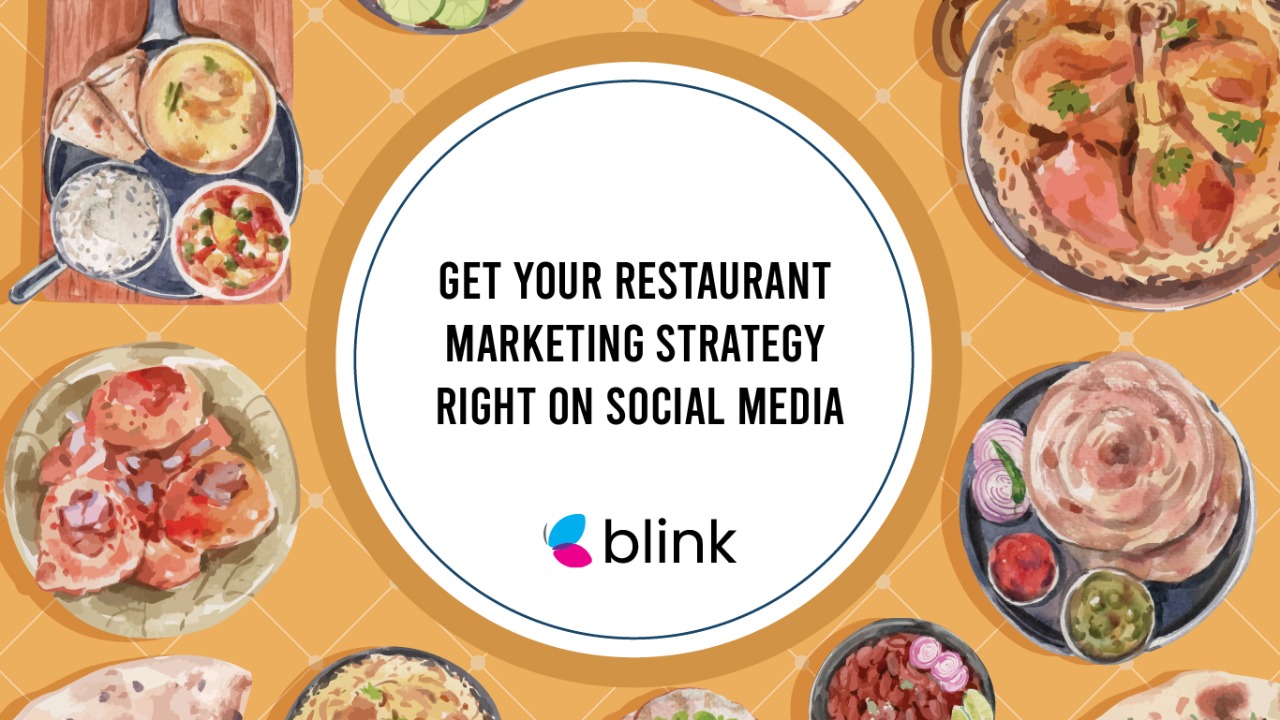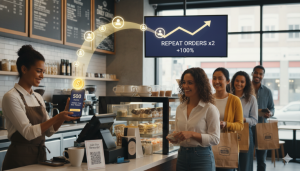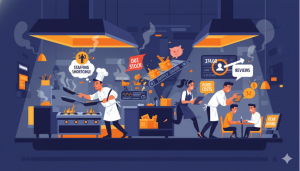How do you design restaurant marketing campaigns? How are restaurants using social media successfully? What are some social media posts for restaurants that get results? These are all valid questions that restaurant owners and managers should be asking themselves.
The restaurant industry is one of the most competitive industries out there. If one is not utilizing social media to its fullest potential, you’re missing out on a huge opportunity to reach new customers and grow your business. We’ve put together this comprehensive guide on social media marketing for restaurants.
In this guide, we’ll cover everything from designing restaurant marketing campaigns that get results, how to use social media successfully, and what kind of social media posts for restaurants work best. So whether you’re a restaurant owner or manager looking to take your restaurant’s social media game to the next level or curious about how to use social media to benefit restaurants, this guide is for you.
How do you design restaurant marketing campaigns?
When it comes to restaurant marketing campaigns, the sky’s the limit in terms of creativity and possibilities. But even if you don’t have a ton of time or money to put into your campaign, you can still do plenty of things to make it successful. For example, one simple but effective restaurant marketing campaign is to offer a discount or freebie for customers who mention your restaurant on social media.
It is a great way to encourage customers to spread the word about your restaurant and help you reach new potential customers. Another restaurant marketing campaign idea is hosting a social media contest or giveaway. It is a great way to generate excitement and engagement around your restaurant and help you reach new customers.
Finally, one of the most influential restaurant marketing campaigns is to create great content that showcases your restaurant in a positive light. It could be anything from behind-the-scenes photos and videos of your kitchen and staff in action, to interviews with your chefs about their favorite dishes, to mouth-watering pictures of your food. No matter what kind of content you create, ensure it’s high quality and gives potential customers a taste of what they can expect if they come to your restaurant.
How are restaurants using social media successfully?
When using social media successfully, there are a few key things to keep in mind. First, it’s essential to be active, present on social media, and post regularly. It will help you build up a following of loyal customers and followers who will help spread the word about your restaurant.
Additionally, when you post on social media, use attractive visuals (photos, videos, etc.) and engaging copy to capture people’s attention. Finally, always respond quickly and courteously to any comments or questions left by customers on your social media pages. It will show that you’re responsive and attentive and help create a positive association with your restaurant.
What are some social media posts for restaurants that get results?
When it comes to social media posts for restaurants that get results, there are a few different types of posts you can make. For example, posts that feature mouth-watering photos or videos of your food are always popular and tend to get a lot of engagement. Additionally, posts that offer discounts or special deals are also usually well-received by customers.
Finally, posts that give potential customers a behind-the-scenes look at your restaurant (e.g., interviews with chefs, kitchen staff, etc.) are also great ways to generate interest and excitement around your restaurant. So there you have it! These are just a few tips on social media marketing for restaurants. If you want to take your restaurant’s social media game to the next level, keep these tips in mind and start putting them into action today.
With approximately 88% of customers influenced by online comments and reviews, having a solid social media marketing plan for restaurants is essential in 2021 & beyond.
If you own a restaurant, or you are just about getting your toes dipped into the food business, you will stumble upon the marketing dilemma – one way or another. Since COVID reformed the normalcy rate at which restaurants used to run and plot their marketing campaigns, the situation calls for innovative ways to operate at different levels.
We’re talking about social media restaurant marketing strategies. They aren’t something new, but due to a majority of people transitioning to remote food order apps, the entire marketing process has also gone through an overhaul.
And yes, we’ll share some interesting statistics with you later down this post, but first, let’s see what the “new normal” modus operandi stipulates for social media restaurant marketing gurus.
The Dummies’ Guide to Social Media Marketing for Restaurants in 2021 & Beyond

There are more than 3 billion social media users who actively engage at different online platforms. It is estimated that this userbase will scale up to at least 3.43 billion, by the end of the year 2023, which begs to raise the question: exactly how many of these users are affect social media restaurant marketing campaigns these days?
Of course, the entire 3 billion-plus userbase isn’t only active on food-related social media pages. It’s a diluted number scattered across multiple niches – and that too, over different industries.
However, the hospitality business, such as; restaurants, eateries, and other name brands is the type of industry that attracts people from all walks of life. Everyone’s got to eat at some time of the day, so why not take it to social media to share the food that people love and cherish for a good number of days?
Why Do You Need to Take Your Social Media Restaurant Marketing Strategy Serious?
If you have been a restaurant owner for a while now, there’s a high chance that your repeat customers are already playing a small part in your restaurant’s social media marketing campaign. In fact, you may not even know about it.
If your restaurant dabbles in creating delicacies with striking visuals, you may find out that hundreds of people share photos of the food via their social media profiles. For all we know, there might be a restaurant hashtag reserved for your business’s name.
Such actions that are done on behalf of any restaurant’s customers are interpreted as social media signals. They’re good, but it’s time to take it to a professional level where you, as a business owner, take charge of the social media restaurant marketing campaign.
To answer the question: why you need to take restaurant social media marketing seriously these days is because of different looming reasons. For starters, we are way past COVID, where food businesses have shifted to online food order portals through different service providers.
Secondly, ever since COVID happened, people have become increasingly active online. Call it the Work From Home protocol in full swing, or spare time on your average customer’s hands; they are partaking in social media signaling now more than ever.
It’s time for you to communicate and resonate with the same level of responsiveness as your customers dote unto your food business. Besides, if you are an operator, the majority of your focus should be on engaging a contactless world that isn’t able to step into your brick-and-mortar establishment like it used to before.
Need to Get a Quick Recap of the Best Social Media Strategies for Restaurants? Read These Tips
If you’re pressed for time, here’s a quick insight on the most important aspects of the best social media strategies for restaurants(s). Incorporate these into your plan, the next time you are about to engage potential customers through social media profiles to see better results.
High-Quality Food Items with Catchy Images:
Nothing sways customers better than drool-worthy imagery of food items. Get a few close-up shots of steaming hot pizza slices with an extra layer of mushrooms and cheese. Else, you can post a few images of beautiful artwork done on a thick coat of cream at the top of your coffee cups.
Images have a way of stimulating hunger, especially when restaurants share them at the right time of the day. This type of strategy is a common part of the social media marketing plan for restaurants. For best results, include hashtags, followed by some sort of description, such as “Lunch/ breakfast menu today at your favorite name-brand restaurant is nothing short of amazing.”
Seasonal, Daily, and Weekly Menus are Need of the Hour:
People get bored easily when restaurants do not post anything new related to an online restaurant menu. As part of an effective marketing technique for restaurants, add a bunch of new food items to your seasonal menu.
If you have a chef’s special dish reserved for the weekend, make sure that your restaurant social media page is updated with a pinned post covering the image and description of the upcoming menu item. This way, customers will remain on top of whatever’s going on in your restaurant’s kitchen.
Encourage Customers to Share Content:
Moving on, our next tip on restaurant marketing campaign strategy is to harness the power of customer engagement through user-submitted content. Thankfully, since everyone has a smartphone with a high-quality camera these days, why don’t you encourage your regulars to post images of their favorite food items from your restaurant?
Doing so also builds up on your credibility as other people who haven’t dined in your establishment, or had the pleasure of ordering something online through your branded food ordering app, can see what fellow customers are posting. This creates a sense of intrigue and helps to create a special kind of buzz about all the exciting food menu items that are yet to be tried.
Post Occasional Chef Interviews and Recipes at Your Restaurant’s Social Media Page:
Although restaurants do not share recipes for their bestselling food items due to privacy concerns, sometimes it’s better to highlight side menu recipes that don’t take too long to prepare. At best, it will encourage customers to cook something on their own and share their cooked food through your restaurant’s social media page.
Alternatively, chef interviews and behind-the-scenes footage create a special connection with your customers. They will have something forward to look to, after every few weeks. Such activities also put restaurants on customers’ favorite list because people give special attention to videos that offer something a tad bit different.
Interested in learning more about restaurant marketing campaign tips? Go ahead and read the rest of the post.
The Right Type of Social Media Restaurant Marketing Strategy for Restaurants Matters A lot: Here’s Why

As of right now, there are tons of different marketing strategies that businesses use to engage their customers. But then again, not all of them are equally effective. This calls for implementing only those social media restaurant marketing strategies that are value-driven.
The best and the most proactive approach is by starting with a goal in mind. As a restaurant business owner, what type of results are you considering when you think about any online marketing campaign?
- Is it an increased number of followers on your restaurant’s Instagram page?
- Are you looking to turn over revenue through limited-time discount sales?
- Do you intend to create a viral social media trend through a hashtag campaign for your restaurant?
- Is there a specific end-year annual goal that you need to achieve through social media restaurant marketing in particular?
To tell you the truth, honestly, there’s no specific uni-directional answer to the above questions. You may be indulged in running social media marketing campaigns for one reason, or it could be for a variety of reasons.
[INSERT_ELEMENTOR id=”2061″]
However, the one thing that’s evident for just about any business in the food industry is an increased number of customers, which eventually contributes to the overall revenue pool. The key is to start small with a limited scope and expand as your business gains traction. That’s how any long-term digital marketing strategy is supposed to work.
Fun Fact: According to a recent post by Telegraph, the most Instagrammed image of a food item is pizza. This is usually followed by Steak, burgers, homemade delicacies, and Sushi.
The next step is to plan your content and time of the day to share your posts. Peak lunch hours are known to have the most number of online active users. Since many social media platforms enable post scheduling, you can push yours after lunch hour posts, and dinner-related signals to later hours of the day. The process is entirely automated and requires a minimum amount of monitoring on your part.
Speaking of automation and social media restaurant marketing, some of the benefits that such activities can reap for you are appended below:
- Increased number of users responding to your posts
- Organized data with increased efficiency
- Ability to create custom content that’s tailored specifically to your audience
Let’s discuss some of the most popular online restaurant marketing techniques, which are being used on the internet these days.
Your Restaurant’s Social Media Profiles:

Setting up a proper profile for any restaurant serves as a founding pillar. Your audience will not only respond to the way your profile is set up, but you will also be capitalizing on the way things are set up initially.
With this point in mind, creating “proper” Facebook, Instagram, and Twitter profiles are imperative. What does that mean?
In case you’re wondering what we’re insinuating by saying ‘Proper’, it means that all your relevant restaurant-related information is where your customers can see it. For Instagram profiles, any restaurant info is supposed to go underneath the description/ profile info section so that your contacts can identify your business easily.
For improved CTA, you can even add a URL to your restaurant’s website. However, we recommend adding a punchy description, followed by a link to any ongoing limited-time discount deal that you’re offering.
Instagrammers love to explore anything that has to do with discount deals, limited-time marketing campaigns, and vice versa.
According to a survey conducted by SevenRooms, approx. 63% of Instagram users reportedly engage in signing up for limited-time food item deals.
To sum it up, setting up your profile means adding all the important information, a link to your website or time-gated food deals, and contact information.
Restaurant Social Media Monitoring:
Social media monitoring for restaurants helps to gather information about different things related to your business.
The kind of Hashtag that’s being used; the type of keywords that people enter to reach your online portal and user demographics etc. This information plays a vital role in enabling online restaurant social media campaign owners to tailor the content that further assists the business in conversions.
Many restaurant owners who have signed up for an account with a food ordering service provider, have access to a White Labeled virtual hub at the back end where all the information related to customers can be easily monitored. Such business partners share details about user demographics, data analytics, keywords, and mentions on social media websites that lead customers to a food operator’s online platform.
As a result, food business operators are able to overlook the following aspects of their business through active social media campaign monitoring systems:
- Online food and service reviews
- Influencer marketing campaign results
- Reputation monitoring and mitigation (*if needed)
- Ability to identify customers’ needs and interest areas
- Ability to highlight business’s pain points
Drool-Worthy Food Imagery Is Kind of a Big Deal!

Great photos, especially when they are close-up shots of food items, sell stuff. Period.
Of course, you’re going to have to add a tagline and a couple of hashtags in the image description for your customers to see, but these photos engage people like none other.
The result is not only an increased number of likes, improved CTA, but also helps the word-of-mouth frenzy that creates awareness about a restaurant’s services on the internet. Although it doesn’t take much on a restaurant’s part to take those snaps, some of the food business operators go an extra length to hire Restaurant Food Photographers from time to time.
Any high-quality image of your food items brings you one step closer to your next customer. Make those dishes look so good that customers are instantly drawn to think, “Damn, I need to order something from XYZ restaurant right now!”
We recommend using filters to spice up your food items’ imagery. You can also use Canva to add after effects to those photos. Some interesting numbers on social media restaurant marketing and food-related photography point out that:
- There’s an approx. 150% increased engagement in tweets and reshares for any post that comes with food images.
- Facebook users are more likely to respond to posts with multiple scrollable images as compared to plain text posts.
It is time for you to show off all the masterpieces that your chef works on behind closed quarters.
[INSERT_ELEMENTOR id=”2061″]
Engaging, Sharing, and Participating:
A very important strategy that plays an important role in social media marketing goals is how you are engaging your customers.
If you own a local brick-and-mortar restaurant, people within the vicinity already know about it. The business has a reputation to uphold. And if it’s an old establishment, you can cash upon it as a restaurant business owner on different social media channels.
It pays to know about what goes on in your local communities and how you’re able to participate in them to the business’s advantage.
For instance, if there’s a charity event going on in your locality, don’t hesitate to contact the event organizers to set up a few food stalls. The fact that your restaurant’s business logo is on the stall matters more than selling food at a profit. Since it’s a charity event, you can keep the cost to a bare minimum.
However, while doing so, don’t forget to take snapshots of the food stalls and share them on social media through your online restaurant profile. This is free marketing, and people always react positively to any food business that plays a role in supporting local communities.
The options are limitless.
Finding Customers on Social Media Isn’t That Hard:
Although there are different ways of engaging with customers, a great way of finding customers on social media is through social media monitoring tools.
People often rely on other individual’s opinions when it comes to trying a restaurant’s menu for the first time. Alternatively, if your restaurant thrives on tourists to make up for a majority of your clientele, it is time to look for social media signals through your monitoring tools.
Look for posts where people are asking for recommendations about local restaurants, or the best food menu to order online. You can reach out to these customers through your restaurant profile by commenting with something intriguing underneath their posts.
Don’t try to upsell or blatantly market your business while you’re at it. Keep it subtle and maintain a consistent approach that’ll keep potential customers curious instead of throwing them off guard.
Emojis are a Great Marketing Tool:

If done correctly, Emojis can lead to improved CTA for any online business.
As part of social media restaurant marketing techniques, food-shaped emojis bring life to posts with relevant images. Don’t take our word for it.
Zazzle respondents recently shared data that reports that food-related posts with emojis had 57% increased engagement as opposed to either plain text posts or simple text posts with images. As a matter of fact, there’s a plethora of food icons and emojis already at your disposal. The question is whether you’re going to incorporate those snazzy images in your upcoming posts or not?
Also, don’t forget that major restaurant name brands already use emojis to engage online customers.

Taco Bell mostly uses Taco-shaped emojis on their social media posts. Why don’t you try to come up with relevant images that relate to your specialty food items to raise a few eyebrows on the internet?
Avoid Negative Customers:
For an angry customer, it doesn’t take much to rant on social media through raving reviews.
Despite their best efforts, many restaurant business owners fall victim to unjust negative customer reviews that have nothing to do with the hospitality or the way the food was served/ cooked. Some people love being negative, and nothing pleases them more to see others revel in the same spirit.
If you stumble upon such reviews, try to ignore them. If it is important to address such negative concerns, respond to the reviewer in a humble and neutral manner. By aggravating those customers, you will only be making the situation worse for your business since online customers will perceive you as a hotheaded business owner who likes to run his mouth.
Another major mistake to avoid when it comes to social media restaurant marketing for dummies is posting irrelevant content. If you have nothing important to post, don’t spam your customers’ newsfeed with food-related memes or anything that might dissuade them. People have a very short attention span, so better to keep your content lit with high-quality information.
Overdoing posts and sharing posts beyond your usual schedule will eventually be perceived as spam. It doesn’t take long for an individual to permanently block your restaurant’s online account from further viewing.
So, be extra keen and vigilant about your content quality on the internet.
Collaborate with Social Media Influencers
When was the last time you had a sponsored collaboration program with a social media influencer?
Also, the type and the category of the influencer that you partner with matter a lot. As of right now, there are three main types of social media influencers:
- Mega Influencers – They have over 1 million followers and multiple social media platform profiles (YouTube, Facebook, Instagram)
- Mid-Level Influencers – They have 100k+ followers, and are widely recognized for their content
- Micro-Influencers – These guys have 10k – 30k+ followers, and are relatively new in the field
Of all the three categories, it’s the micro-influencers who have the highest engagement rate. Research shows that micro-influencers have an audience engagement rate of 3% to 4%, whereas mega influencers’ engagement rate is somewhere around 1% – 2%.
Micro-influencers are easier to work with; their pricing plans are low, and they are very easy to approach. Set up multiple campaigns with different micro-influencers for your social media restaurant marketing strategies to reach different audience clusters across various countries.
Compare the results against your KPIs to monitor conversions and customer acquisitions.
Use Restaurant Email Marketing to Retain New Referral Traffic
Referral traffic is the new visitors coming to your restaurant food ordering app, or website through some kind of collaboration program with a social media influencer.
In order to make sure that the conversion is not just a one-time effect, make sure that you have some sort of CTA, strapline, or pop up on your restaurant food ordering online portal to get visitors’ email addresses. Once you have those emails, create a new email list to connect with these referrals afterward.
Create custom newsletters via Opt-in Monster, MailChimp, or SendGrid to get in touch with your recently acquired online referral traffic. This is a globally practiced strategy that has been known to affect customer retention and acquisition rates for brands from all over the world.
Bank on User Generated Content (UGC)
User-generated content is a totally free social media restaurant marketing strategy based on your online visitors’ submissions. All the photos, tweets, and online social media activity happening at your customers’ end, while they tag your restaurant page in it, will result in additional referral traffic.
From a long-term perspective, your fans will be doing the majority of the marketing work as long as you recognize their efforts, give them shoutouts or credit where it’s due. Depending on the quality of the content, make sure that you repost it on your restaurant’s official social media page to demonstrate compassion for the community – so on and so forth.
At the End of the Day:
Keep in mind that for any social media restaurant marketing strategy to work, it takes time and effort. Don’t expect overnight results. It takes time for people to respond to online posts. The key is to keep at it and remain regular with your social media signaling as much as possible.
Alternatively, you could partake in paid digital marketing campaigns, but they are a temporary fix to a permanent issue. Remaining active is an efficient way of reminding your customers that you have something to offer, and all the different ways you can cater to an average Joe’s palate from time to time.
Related Articles:
 50 of the Best Restaurant Marketing Strategies in 2023 To Follow
50 of the Best Restaurant Marketing Strategies in 2023 To Follow
 Restaurant Social Media Marketing; 5 Best Strategies For New Businesses
Restaurant Social Media Marketing; 5 Best Strategies For New Businesses
 Restaurant Guide: How To Convert Third Party Customers To Direct Ordering?
Restaurant Guide: How To Convert Third Party Customers To Direct Ordering?
 6 Restaurant Marketing Mistakes and How to Avoid Them
6 Restaurant Marketing Mistakes and How to Avoid Them
 How restaurants should manage aggregators in 2023
How restaurants should manage aggregators in 2023




